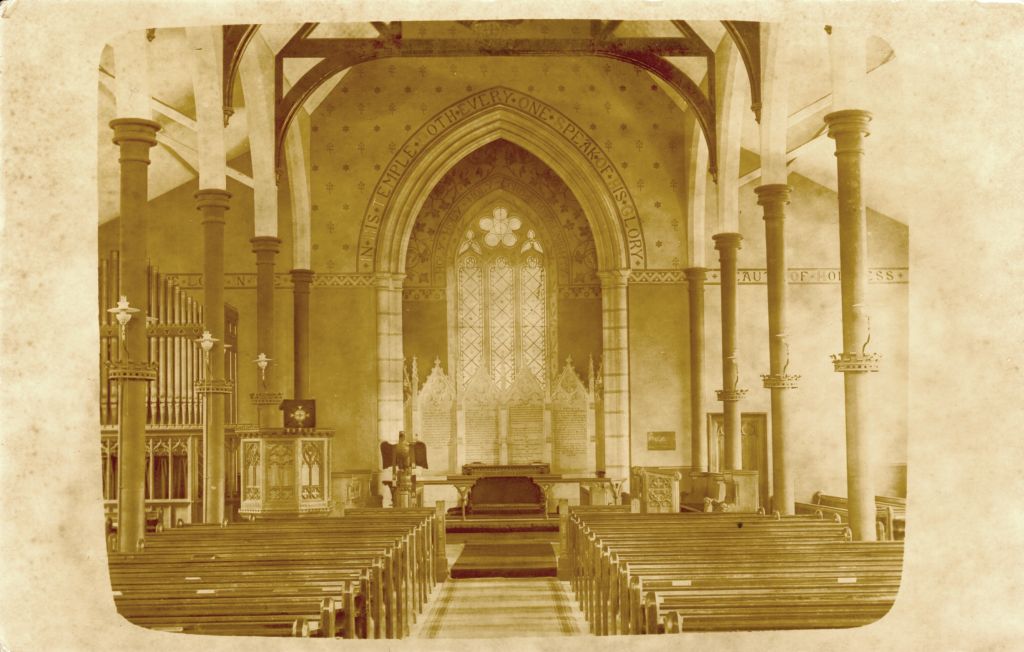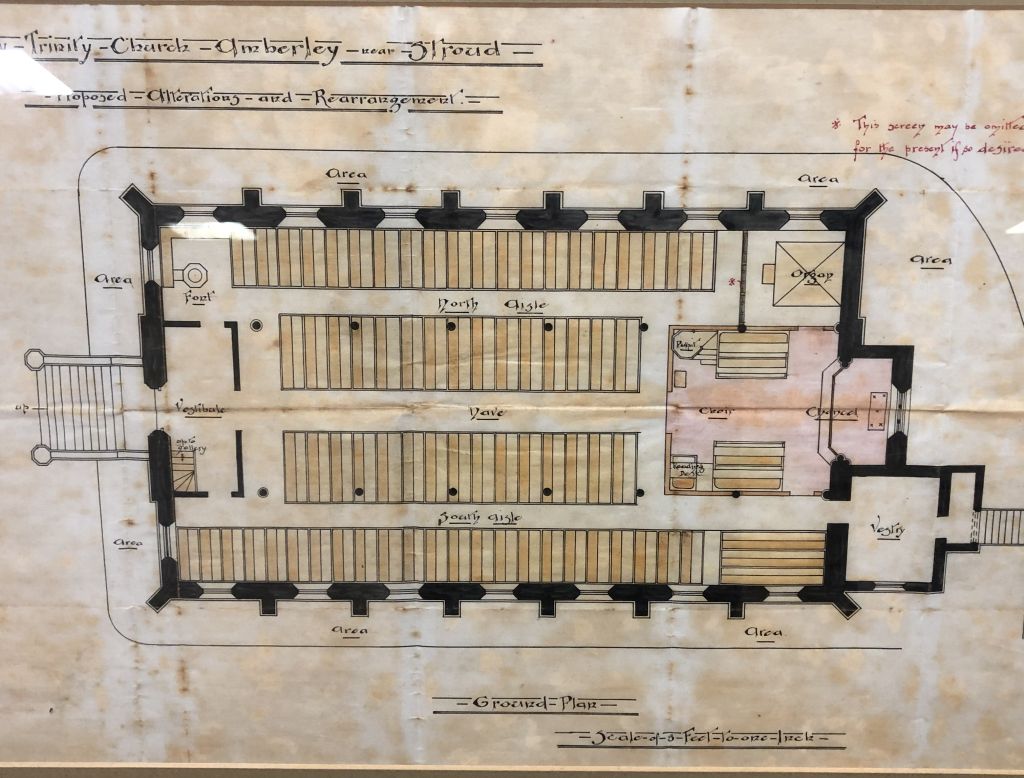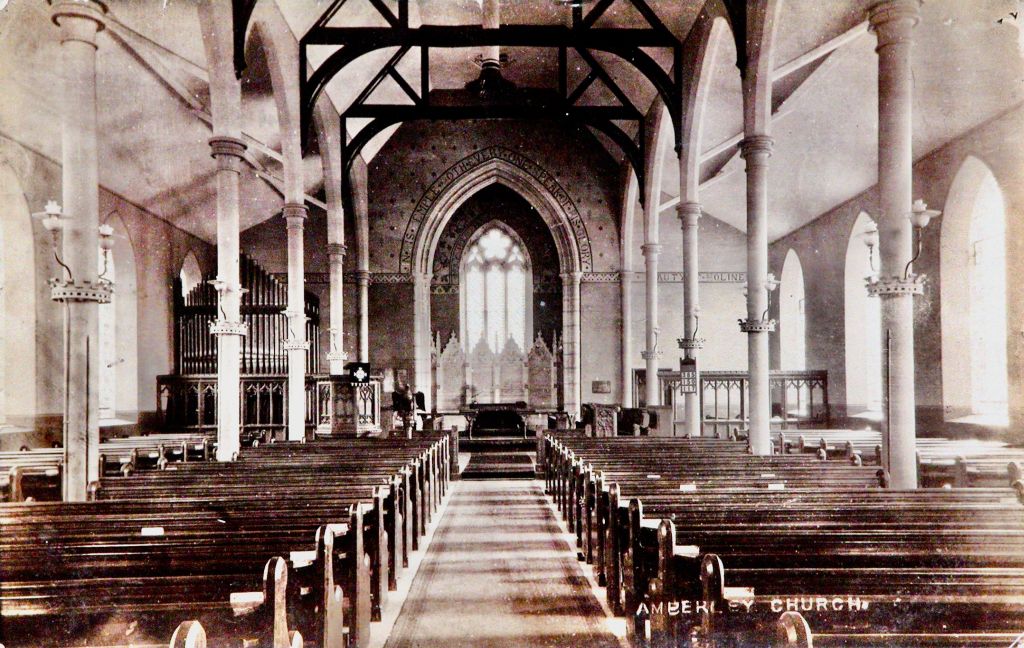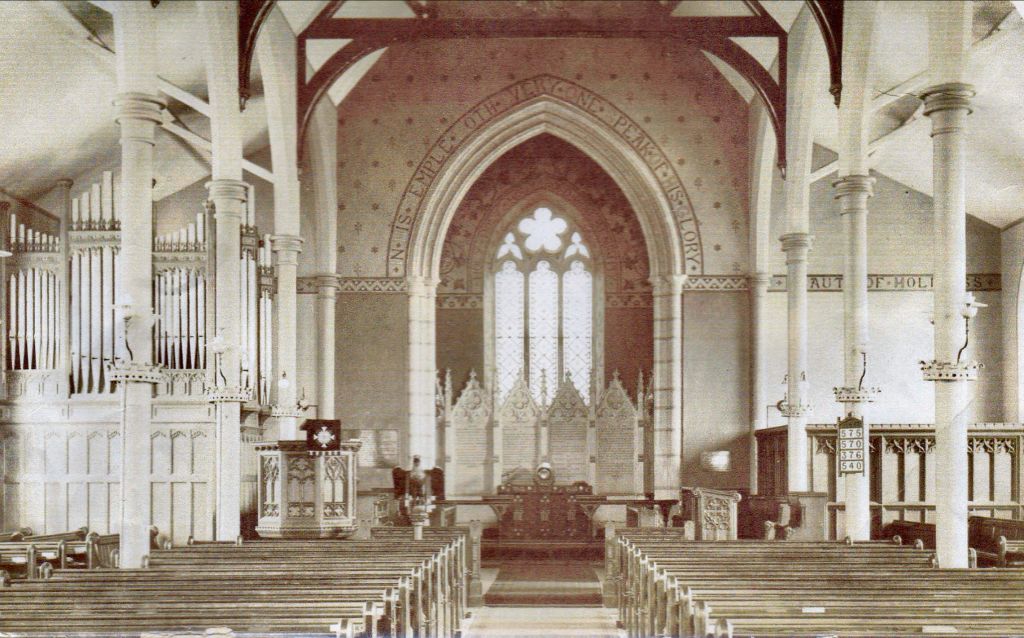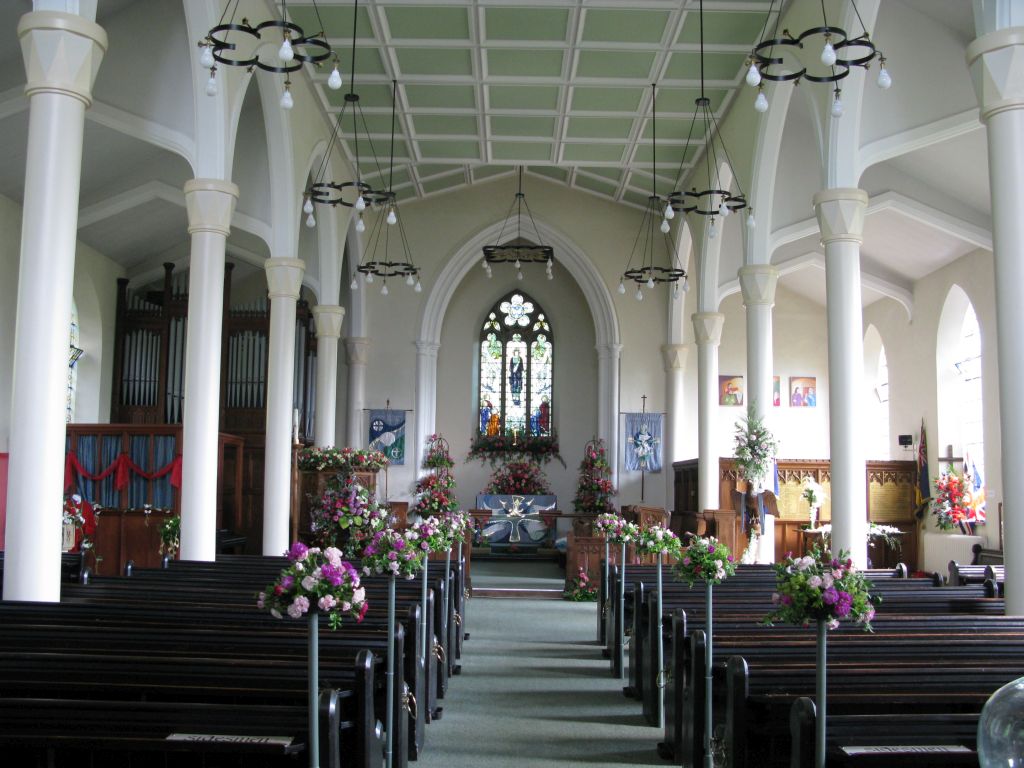Since Norman times Littleworth (Amberley) was part of Minchinhampton and people walked across the Common to their Parish Church there.
The Building of Amberley Parish Church
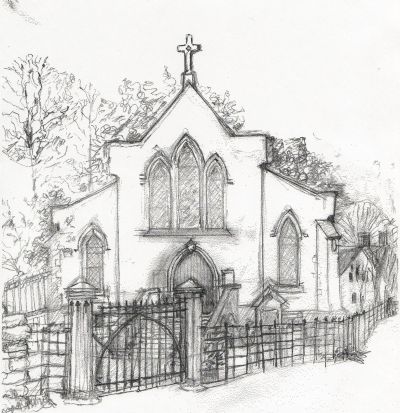 By 1800 the Industrial Revolution was well under way and the population increased all around. The French Revolution caused considerable anxiety among the British Establishment and ways were sought to keep the population from following the example of the French people. Between 1834 and 1846 eight new Anglican churches were built in the Stroud Area.
By 1800 the Industrial Revolution was well under way and the population increased all around. The French Revolution caused considerable anxiety among the British Establishment and ways were sought to keep the population from following the example of the French people. Between 1834 and 1846 eight new Anglican churches were built in the Stroud Area. In 1836 the Lord of Hampton Manor was the economist, David Ricardo of Gatcombe Park, now occupied by Princess Anne. It was through the generosity of David Ricardo that Amberley Church was built – as a token of his gratitude to God for the miraculous escape from serious injury of his son, also called David, in a riding accident.
In 1836 the Lord of Hampton Manor was the economist, David Ricardo of Gatcombe Park, now occupied by Princess Anne. It was through the generosity of David Ricardo that Amberley Church was built – as a token of his gratitude to God for the miraculous escape from serious injury of his son, also called David, in a riding accident.
To the Glory of God
and for the good of the people of Amberley
this church was built at the sole charge of David Ricardo, Esq.of Gatcombe Park, Minchin-Hampton
and consecrated to the service of
Almighty God
September, 5th 1836This tablet was erected in the jubilee year of the Church 1886
There is some doubt about the name of the architect, but it may have been a Mr. Stokes of Cheltenham. The builders were George & Daniel Harrison of Kings Stanley who had been involved with the building of the Subscription Rooms in Stroud. The hill was excavated so that the building could stand, according to good biblical teaching, on the rock. There is a Room underneath the Church, originally used as a school. The Church is built in a north/south line to fit in with the contours of the hill. Originally, it had a bell cot over the (ecclesiastically) west end (geographically north), which had to be removed in 1950 as it had become unsafe.
The Gloucester Journal of Saturday 10th September 1836 reported on the consecration:
The consecration of this edifice took place on Monday last, and excited the greatest interest in the surrounding neighbourhood; many parties also went from this town to witness the impressive ceremonial, and there was a very numerous assembly of the manufacturing and labouring population. The Lord Bishop of the Diocese arrived at 11 0’clock, attended by his chaplains, secretary, registrar, etc., and was received at the gate by David Ricardo Esq., and upwards of 30 of the clergy of the Diocese at the door of the church.
The petition was presented and read to his Lordship, praying him to consecrate the church, after which his Lordship proceeded to the vestry, and having robed, passed down the aisles in procession, followed by his clergy repeating the 24th Psalm, until he arrived at the communion table; the deed of conveyance was presented to him, when the Bishop proceeded with the consecration service, after which the sentence of consecration was read by the Chancellor and signed by the Bishop, and laid upon the communion table. The morning service was then commenced by the Rev. Mr Blackwell, the Incumbent.
The church was crowded to excess, there being upwards of 1200 persons within the building, and nearly 2000 persons outside, who were unable to gain admittance. After the service had been read, the Rev. F. Close, our highly respected Incumbent, preached a most impressive and eloquent sermon from Acts v 42 ‘and daily in the temple and in every house, they ceased not to teach and preach, Jesus Christ’, which was listened to with the deepest attention, and which we trust the Rev. Gentleman will be induced to publish.
Towards the conclusion of his discourse, while directing the attention of the congregation to the truly Christian munificence of the founder in thus, at his sole expense, building and endowing a church to the service of Almighty God, he took occasion to mention the gratifying fact that although the schools beneath the church had been open only a fortnight, yet they now contained one hundred and eighty three children, all belonging to the immediate surrounding district, and the greatest part of whom had not attended any school. After the conclusion of the sermon, the Bishop proceeded round the church to consecrate the Burial Ground, which concluded the ceremonial.
The church, which has been munificently erected and endowed by Mr. Ricardo, is a very elegant structure in the Gothic style, designed by Mr. Stokes, architect, of Cheltenham, and does honour to the talent of that Gentleman. The western front is a very pleasing composition; over the door, which is reached by a flight of steps, is placed a bold triple window with pointed arches, and above this rises the bell tower; on each flank is a single window in the same style as that over the door way. The arrangement, though simple, has a very excellent effect. The interior accommodations are good, being calculated for 700 persons, exclusive of any galleries which may hereafter be erected. The length of the interior is 82 feet. Its breadth 43 feet and the height 30 feet. The altar piece is placed in an arched recess under the eastern window, and on the right of the altar is a doorway leading into a good-sized v-room. The School rooms are situated under the church, and are both light and airy, being 45 feet by 40 feet, and 13 feet high. The building is warmed with hot water in a very ingenious and effective manner, by Mr. Price, of Birmingham. We should not forget to mention that Mr. Ricardo has not only built a church and school Rooms: but to make his noble act of liberality complete, he has erected a commodious Parsonage House for the Incumbent. Such deeds as these do not require the tongue of praise or adulation to make them known or appreciated.
Inside the Church
The Church was originally built as a simple rectangular shape without a gallery. The earlierst picture we have is thought to be around the late 1890s as we know the choir stalls were installed in 1896. The architect's early plans to get to this stage are also shown.
(Click for a larger version of all the pictures on this page.)
Around 1905/6 the screen on the right was added. Initially it was open...
By the 1920s, the screen on the right had been boarded over behind and the organ had been rebuilt....
The screen on the right was renovated by the British Legion early in the 21st century and the names rearranged to accommodate the centrally placed cross.
The oak Pulpit and Lectern were presented by Mrs. Caroline Blackwell in memory of her father, John Griffiths Frith, of The Highlands, now Beaudesert Park School, and her husband, the Rev. Robert Edward Blackwell, Amberley’s first Rector.

Over the years Amberley Church has received many gifts – a silver processional cross, silver and brass plates, brass cross and candlesticks, reading desks and book cases. Most of these items are in general use in the regular services.
The font used to be just inside the Church door on the north side (ecclesiastical). But when the vestibule was enlarged to accommodate the ramp the font was moved and is now placed near the organ at the front of the Church; this move has been very helpful because Baptisms usually take place during the morning service when the regular congregation is able to join with the family in welcoming a new member of the Christian Family.
Rectory and Graveyard
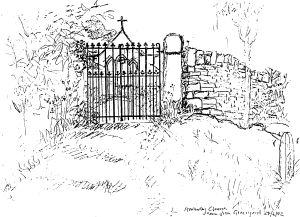 At about the same time the Rectory, next door to the Church, was demolished and rebuilt because it too was unsafe. There are springs, soft clay and fuller’s earth to be found in parts of Amberley which have caused problems over the years. The graveyard was originally on the grassy slope above the Church, but, soon after it was established, this slipped, in a mighty rush of water it is said, while the sexton was at his task. A new graveyard was created on the lower side of the Church, across the road.
At about the same time the Rectory, next door to the Church, was demolished and rebuilt because it too was unsafe. There are springs, soft clay and fuller’s earth to be found in parts of Amberley which have caused problems over the years. The graveyard was originally on the grassy slope above the Church, but, soon after it was established, this slipped, in a mighty rush of water it is said, while the sexton was at his task. A new graveyard was created on the lower side of the Church, across the road.
This has many lovely trees and is believed to have been set out by someone from Westonbirt Arboretum. The grave of PC Wren, author of Beau Geste, is on the right going down below the Garden of Rest. Major General Sir Fabian Ware’s memorial is at the far end of the graveyard and is in the style of the graves in Europe and elsewhere looked after by the War Graves Commission, the establishment of which was Sir Fabian’s great achievement. Photographs of all the gravestones in the Amberley and Littleworth graveyards have been taken, indexes made and, where possible, information about all these people recorded.
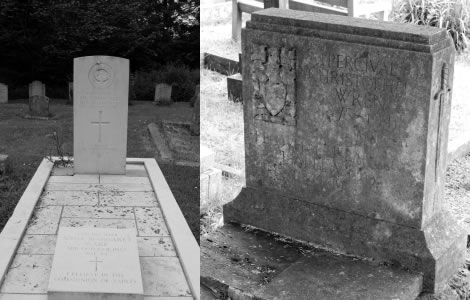
The Clergy
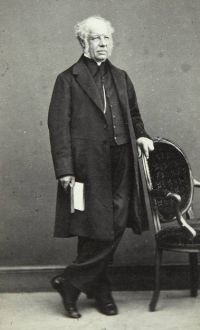 The Rev. R.E. Blackwell, the first Rector, was in Amberley for 36 years and had a tremendous influence on his parishioners. His picture, along with all the succeeding incumbents, may be found on the Vestry wall.
The Rev. R.E. Blackwell, the first Rector, was in Amberley for 36 years and had a tremendous influence on his parishioners. His picture, along with all the succeeding incumbents, may be found on the Vestry wall.
During his incumbency, Rev. Blackwell arranged for photographs to be taken of the parishioners, many of his friends, and some famous visitors – including Mr. Gladstone. These photos are in five beautiful volumes and are housed in the Gloucester Record Office, for safety. There are also volumes of his sermons and some sketch books. Arrangements are being made at the present time (2007) for copies of the photographs to be kept in Amberley’s own Archives. During celebrations for the 150th Anniversary of the creation of the Parish (1986) a further collection of photographs was made of all the Amberley families, standing in front of their homes. These too are in the Gloucester Record Office.
Since 2009, Amberley has been part of the Benefice of Minchinhampton with Box and Amberley
Past Rectors
Rev R.E. Blackwell, 1836-1872
Rev R.J. Mooyaart, 1872 –1884
Rev W. Bryan-Brown, 1884-1892
Rev H. Summerhayes, 1892-1908
Rev F.E. Warner, 1908-1935
Rev S.G. Bush, 1935-1947
Rev S.H.A. Bennett, 1947-1958
Rev A.F. Maltin, 1959-1966
Rev C.D.J.G. Burslem, 1967-1987
Priests-in-Charge
Rev J. Simmonds, 1988-1992
Rev Dr M.O. Tucker, 1993-2009
Associate Priests (since the combined benefice was formed)
Rev Ann Morris, 2009-2014
Rev Brian Atkinson, 2014-2017
Rev John Spiers, 2017-
The Methodists
A strong free-church tradition grew up in the 18th Century. John Wesley and George Whitefield are both said to have come to the Stroud area and there is a little hillock on the Common near Moor Court, called “Whitfield’s Tump”, where George Whitefield is said to have preached to a huge crowd of people.  There still exists a licence for services to be held on that little hillock. As well as services in the open air, several of the cottages were used for worship and in 1790 the Littleworth Wesleyan Chapel was built. After 200 years of very active life this Chapel was closed and sold and its congregation, small by then, joined Amberley Parish Church, which became a Local Ecumenical Project in 1990. The Vestry, renamed The New Room, has been retained and is used for prayer by the joint congregation.
There still exists a licence for services to be held on that little hillock. As well as services in the open air, several of the cottages were used for worship and in 1790 the Littleworth Wesleyan Chapel was built. After 200 years of very active life this Chapel was closed and sold and its congregation, small by then, joined Amberley Parish Church, which became a Local Ecumenical Project in 1990. The Vestry, renamed The New Room, has been retained and is used for prayer by the joint congregation.

